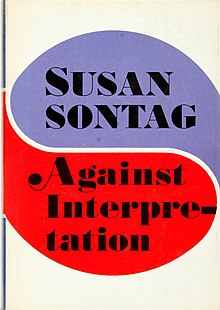Susan Sontag
Sontag was active in writing and speaking about, or traveling to, areas of conflict, including during the Vietnam War and the Siege of Sarajevo.
She wrote extensively about literature, photography and media, culture, AIDS and illness, war, human rights, and left-wing politics.
[5] Remembering an unhappy childhood, with a cold, alcoholic, distant mother who was "always away", Sontag lived on Long Island, New York,[1] then in Tucson, Arizona, and later in the San Fernando Valley in southern California, where she took refuge in books and graduated from North Hollywood High School at the age of 15.
Leo Strauss, Joseph Schwab, Christian Mackauer, Richard McKeon, Peter von Blanckenhagen, and Kenneth Burke were among her lecturers.
[8] At 17, Sontag married writer Philip Rieff, a sociology instructor at the University of Chicago, after a 10-day courtship; their marriage lasted eight years.
She attended Harvard University for graduate school, initially studying literature with Perry Miller and Harry Levin before moving into philosophy and theology under Paul Tillich, Jacob Taubes, Raphael Demos, and Morton White.
[14]: 38 Sontag researched for Rieff's 1959 study Freud: The Mind of the Moralist before their divorce in 1958, and contributed to the book to such an extent that she has been considered an unofficial co-author.
[16] Sontag was awarded an American Association of University Women's fellowship for the 1957–58 academic year to St Anne's College, Oxford, where she traveled without her husband and son.
[17] There, she had classes with Iris Murdoch, Stuart Hampshire, A. J. Ayer, and H. L. A. Hart while also attending the B. Phil seminars of J. L. Austin and the lectures of Isaiah Berlin.
[18] In Paris, Sontag socialized with expatriate artists and academics including Allan Bloom, Jean Wahl, Alfred Chester, Harriet Sohmers, and María Irene Fornés.
She elevated camp to the status of recognition with her widely read 1964 essay "Notes on 'Camp' ", which accepted art as including common, absurd, and burlesque themes.
In the essays, she outlined her theory of taking pictures as you travel: The method especially appeals to people handicapped by a ruthless work ethic—Germans, Japanese and Americans.
[25] Discussing photographs of Diane Arbus, Sontag writes on borders and landmarks of the photo program of beauty.
[27] "In teaching us a new visual code, photographs alter and enlarge our notion of what is worth looking at and what we have the right to observe" and has changed our "viewing ethics".
The truth is that Mozart, Pascal, Boolean algebra, Shakespeare, parliamentary government, Baroque churches, Newton, the emancipation of women, Kant, Marx, Balanchine ballets, et al, don't redeem what this particular civilization has wrought upon the world.
[35] Further research led Lavagnino to identify several passages that appeared to have been taken without attribution from an essay on hypertext fiction by Laura Miller published in the New York Times Book Review six years earlier.
[36] Writing for the Observer, Michael Calderone interviewed Sontag's publisher, who said, "This was a speech, not a formal essay", and that "Susan herself never prepared it for publication".
"[40] In a 2000 article for Harper's Magazine's that was later included in his book Hooking Up, Tom Wolfe called Sontag "just another scribbler who spent her life signing up for protest meetings and lumbering to the podium encumbered by her prose style, which had a handicapped parking sticker valid at Partisan Review.
[43] Paglia also recounts a visit by Sontag to Bennington College, in which she arrived hours late and ignored the agreed-upon topic of the event.
Only a woman of her prestige could have performed the necessary critique and debunking of the first instant-canon feminist screeds, such as those by Kate Millett or Sandra Gilbert and Susan Gubar, whose middlebrow mediocrity crippled women's studies from the start ... No patriarchal villains held Sontag back; her failures are her own.Seemingly unaware of Sontag's choice to live in Sarajevo during the siege, in his book Skin in the Game, Nassim Nicholas Taleb criticizes Sontag and other people with extravagant lifestyles who nevertheless declare themselves "against the market system".
After the opening performance of the play, the city's Mayor, Muhamed Kreševljaković, came onstage to declare her an honorary citizen, the only foreigner other than the recently departed United Nations commander, Lieut.
[1] Sontag died in New York City on December 28, 2004, aged 71, from complications of myelodysplastic syndrome which had evolved into acute myelogenous leukemia.
Upon splitting with Fornés, she was involved with an Italian aristocrat, Carlotta Del Pezzo, and the German academic Eva Kollisch.
[55][56] During the early 1970s, she lived with Nicole Stéphane, a Rothschild banking heiress turned movie actress,[57] and, later, the choreographer Lucinda Childs.
[59] With photographer Annie Leibovitz, Sontag maintained a close romantic relationship stretching from the later 1980s until her final years.
"[68] Following Sontag's death, Steve Wasserman of the Los Angeles Times called her "one of America's most influential intellectuals, internationally renowned for the passionate engagement and breadth of her critical intelligence and her ardent activism in the cause of human rights.
"[70] He observed that "despite a brimming and tartly phrased political sensibility, she was fundamentally an aesthete [who] offered a reorientation of American cultural horizons.
A digital archive of 17,198 of Sontag's emails is kept by the UCLA Department of Special Collections at the Charles E. Young Research Library.
[89] Her archive—and the efforts to make it publicly available while protecting it from bit rot—are the subject of the article On Excess: Susan Sontag's Born-Digital Archive, by Jeremy Schmidt and Jacquelyn Ardam.
[94][95] In February 2023, Screen reported that Brouhaha Entertainment was producing a biographical film directed by Kirsten Johnson and featuring Kristen Stewart as Sontag.



